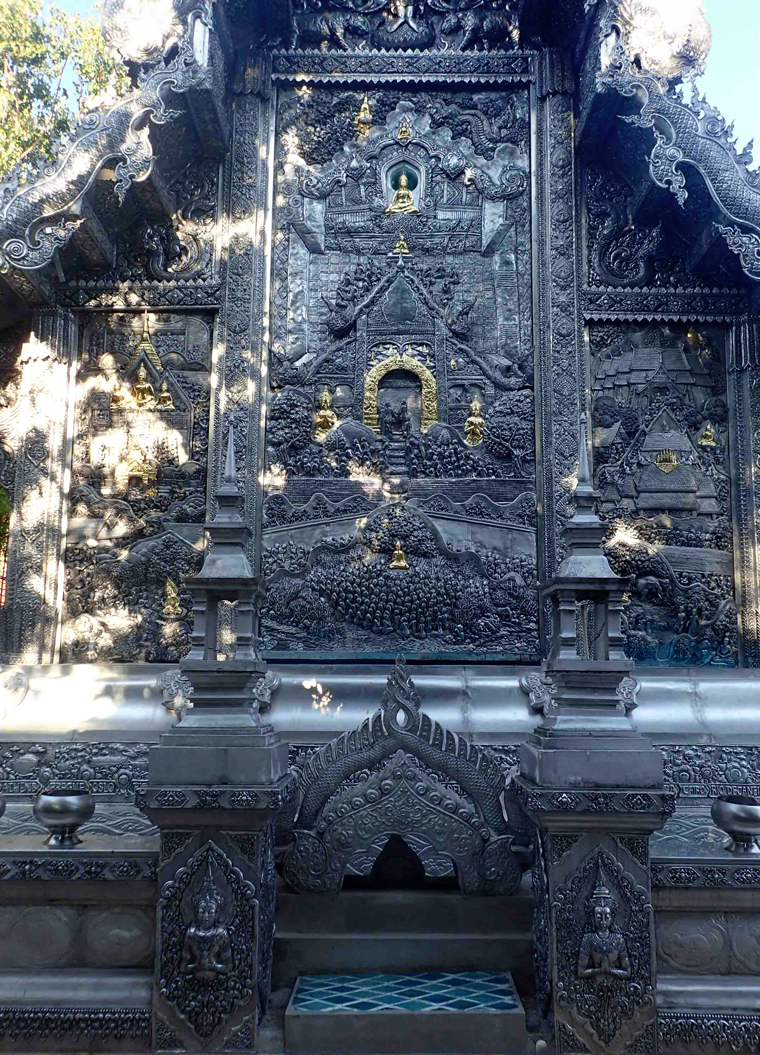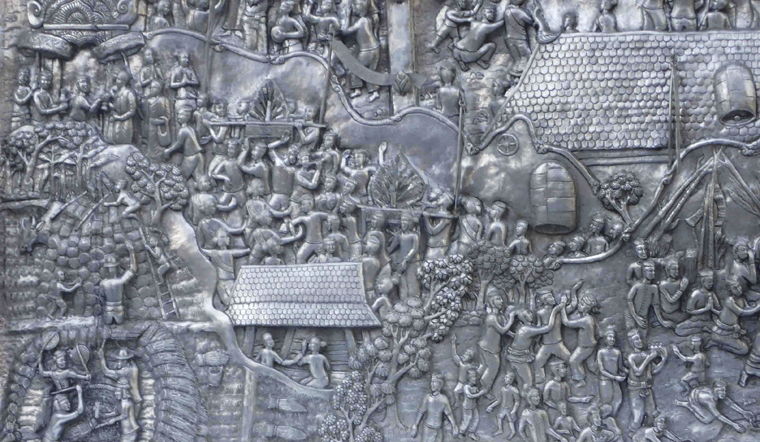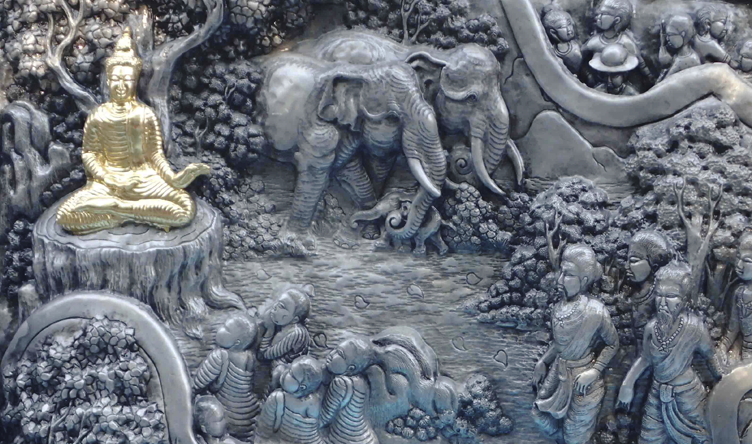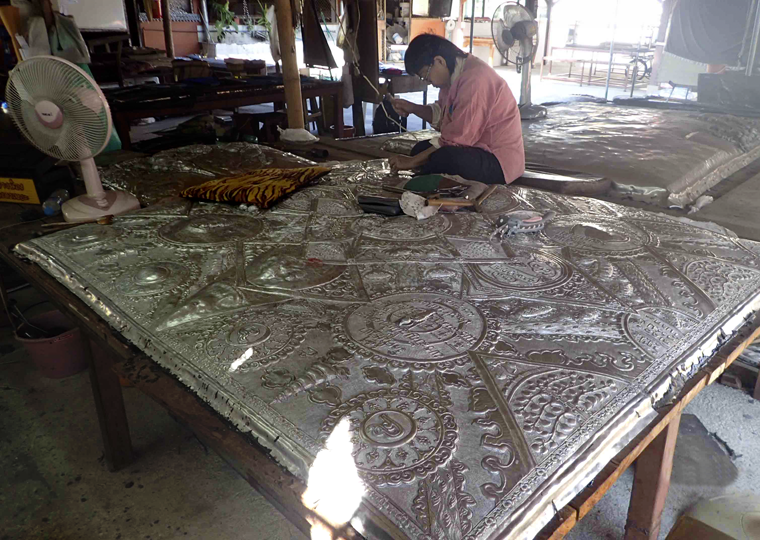Denny Turner in Thailand
Note from the editor: SDMG instructor Dennny Turner was invited to spend three months in Thailand, where he was accepted to study with the monks at the Wat Sri Suphan in Chiang Mai. Beginning in November, Denny has been an artist-in-residence learning "aluminium embossing" – or what we call chasing and repoussé. He has been teaching this subject in his SDMG classes for a few years, but, in Chiang Mai, according to Denny, he has been learning a great deal from masters of the craft. The Wat has one building called the "Silver Temple", and it is covered in a variety of metals, including silver and aluminum – all of which are worked in embossed style. The temple is still under construction, so the community and the Wat monks have a school where they teach the art, so they can finish the main temple and sell works to the tourists and visitors to benefit the congregation.
Denny's first post describes his second day of class working on an aluminum embossing project, which had been started by previous students.
Second day of class
November 3, 2015
by Denny Turner

The facade of the "Silver Temple" at the Wat Sri Suphan in Chiang Mai is clad in aluminum embossed panels.

This panel typifies the complex compositions and textures employed in producing the aluminum embossed panels.

Detail of an aluminum embossed panel with the gilded Buddha contrasting the supplicants and other compositional elements in the scene.

My instructor Tu works on panel measuring about 8' x 10'. Surrounded by her tools of the trade, she sits cross-legged on top of the panel as she works, applying her weight to flatten an area where the pitch backing produced an unwanted bump in the front of the composition.
I have been in Thailand for four days. I've just completed my second day of class. In the morning, I got breakfast at one of the many outdoor noodle cafes and stopped at a lovely little coffee shop and bakery right around the corner from my hotel, where I picked up a half dozen pineapple cake rolls to take to class. They make some deadly nice stuff here, and it could become addictive. My teacher met me promptly at 9:00am, and I opened up the pastries. She asked, "Did you eat all that for breakfast?" And I said, "No, they're for teacher and fellow workers." So, I set the pastries out, and several monks and another worker gathered around – they were very glad to take one.
My assignment is to re-do a panel some earlier student(s) messed up and didn't finish. It's about 10 inches by 18 inches. It is a complex composition of a pair of birds with fancy tails sitting on a lotus blossom that looks like a firey explosion, with some flowers and vines winding around. The first step in a project is to line the pattern onto the metal.
Whoever started this project that I am now fixing did not know how to do lining. She or he basically tried to stamp the pattern and obviously paid no attention to what the lines were portraying – it was apparent that it got really hard to figure out parts of the design. The part I was told to work on seemed to be the worst part of the work. Now, lining is tough work anyway, but having to fix somebody elses messed-up work is a real challenge. Tu said, "You make lines pretty well. Now, go over all the lines, and make them deeper. Then, we'll add detail later."
Before starting, we took the metal, which had some black tar on the back, and added more of the gooey black pitch. Tu showed me where to find a big pile of chunks of what looks like roofing tar. She scooped up a good double handful and spread it on the back. The piece already had a curve in it from the earlier work. She showed me a big tank of gas and what looked like a sidewalk melting torch attached to it. I asked what kind of gas it was. She said, "Same kind used for cooking," so I suspect it was propane. She showed me how to light the torch using a Bic lighter. Tu then showed me how to melt the pitch without making it smoke too much or inadvertently setting it on fire. She showed me a fairly large burn mark on her forearm and warned me to be careful and to always wear long sleeves and long pants when working with pitch. "You don't want a burn like I got when a student knocked over a piece and set fire to the tar." Sounds just right to me. She watched me carefully to see how I handled the torch and seemed happy with how I did it. We let the pitch cool.
Then came the weird part.
I took the panel with the (mostly) cooled pitch to my work area. I covered the area with a big black garbage bag and laid the piece onto the plastic, placing the side covered in still-warm tar face down. Then I folded up the plastic bag around the edges of the tar and the panel. At each corner, I took four big nails and pounded them through the folded plastic, through the aluminum of the piece itself, through the pitch, and into the work bench. Then, I took a bunch of smaller nails and hammered them all around the edges, so the piece was firmly fixed to the workbench and could not move. Therefore, I had to move all around the piece to work on it. Now, this is a small task (by my instructors' standards). Because I was working at a small table, I could get to all parts of my piece. But Tu is working on a ceiling panel that measures about 8 x 10 feet. It sits on one of the huge work tables and she sits cross-legged on top of the piece to work on it. It's nothing to see workers walking on their pieces, especially if there is a lump they don't want. Tu laughed when I asked her about it. She said, yes, one can warm up a bump to make it flatter by sitting on it for a couple hours while working on an area adjacent to it.
I set out to reline and correct several thousand lines that had chatter marks, omissions and just plain mistakes. I became one of the interesting tourist attractions, with many passers-by stopping to watch me work. Many of them were interested to find that an Anglo from America could do this work and that I was allowed to be part of the school. I probably had my photo snapped 20 times today, more than most of the other folks working. Maybe that was because I spoke English and was happy to stop and chat a bit with the tourists. Well, you know me. It was fun to chat. It's amazing how many people from all around the world, including Asia, speak at least some English. The Asian tourists took the most photos.
The monks who do the embossing work all want to play with the tools I brought. They are especially fascinated with my little red roll-up kit and my hammers. They are impressed with the quality and shininess of the steel, as they mostly use whatever steel is available, and good quality carbon steel is rare. As they came around and watched my progress, I got nods of approval. Some of them rubbed their hands over the work, and gave affirmative comments of "Good, good." So, maybe I am more than a prideful foreigner with fancy tools but with no idea how to use them. Tu gets me going and comes around every hour or so, saying, "now you do this." She hardly ever has a comment or criticism, unless I ask for help or clarification about what lines are doing what – "are these lines part of the flower stems?" – then, Tu will say, "Yes, do like this," and she does some clarifying line work. She said at the end of the day, "You are a good student. Work by yourself. Some students need me every couple of minutes, so I get no work done." I guess I'm doing okay.
I think this bloody piece is going to take me the rest of the week just to correct all the lines. One of the monks, a young fellow in his 20s who does really amazing work, came by and showed me some detailed chasing work on my piece, but Tu shooed him away. Later, she relented and showed me some tricks for making the bird feathers. So, I get to do a little chasing as I go along now, I guess. I'm having a ball.
One of the "tourists" who came around turned out to be a local guy with some foreign friends. He told me his mother did this type of work for much of her life, and he had learned a bit 30 years ago. I told him I was inspired by some of the things I found here. He said some of it is good, but there aren't as many masters as there used to be. "You should see some of the pieces I have in my house." Pointing to the stuff hanging on walls around me, he observed, "These are nothing in comparison." Well, the things around here blow my mind, so I cannot imagine what he has that are so much better, and I told him so. He just smiled, nodded his head, and left saying, "Welcome to the tradition."
And that was my day today. I am humbled. And anxious to fix the next thousand lines on my piece.
